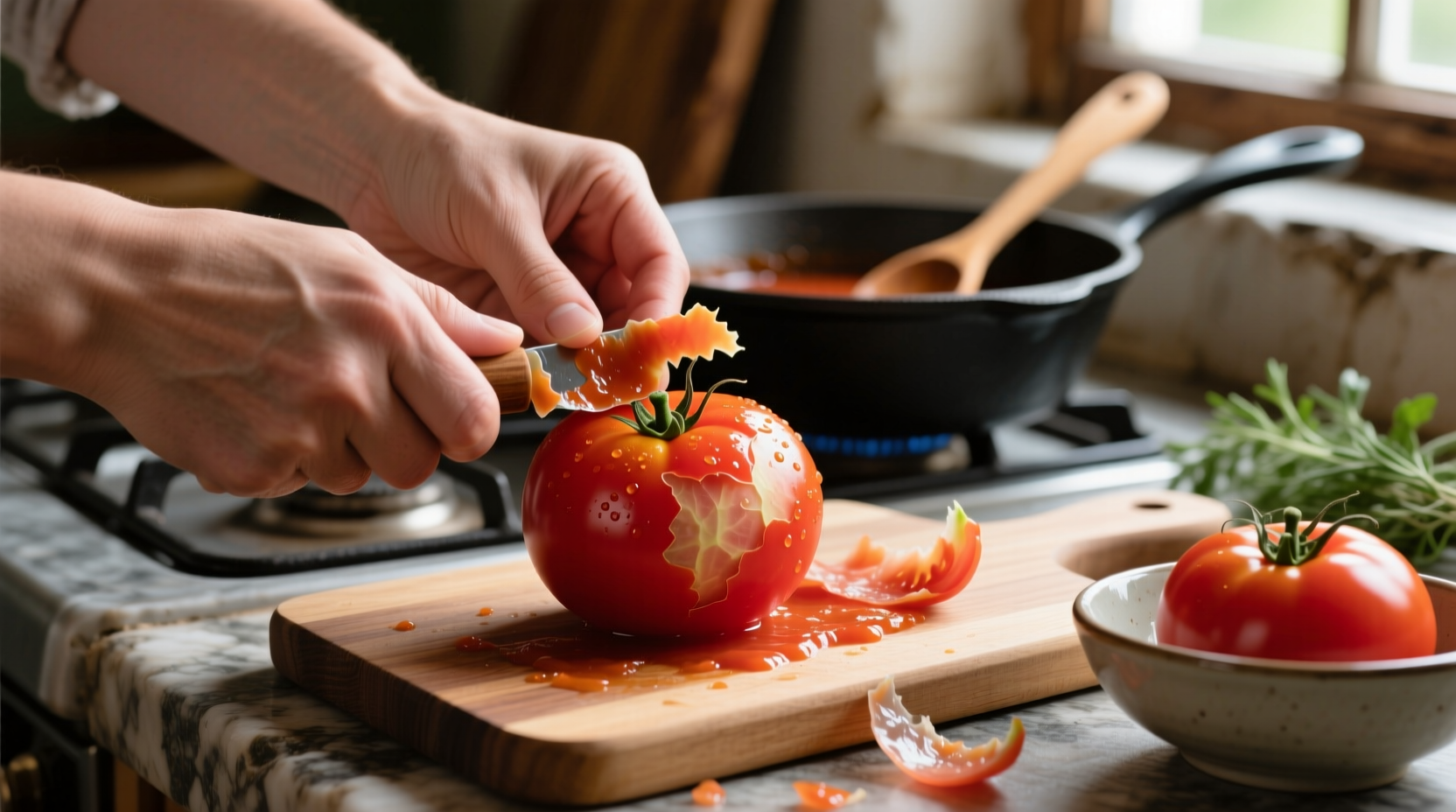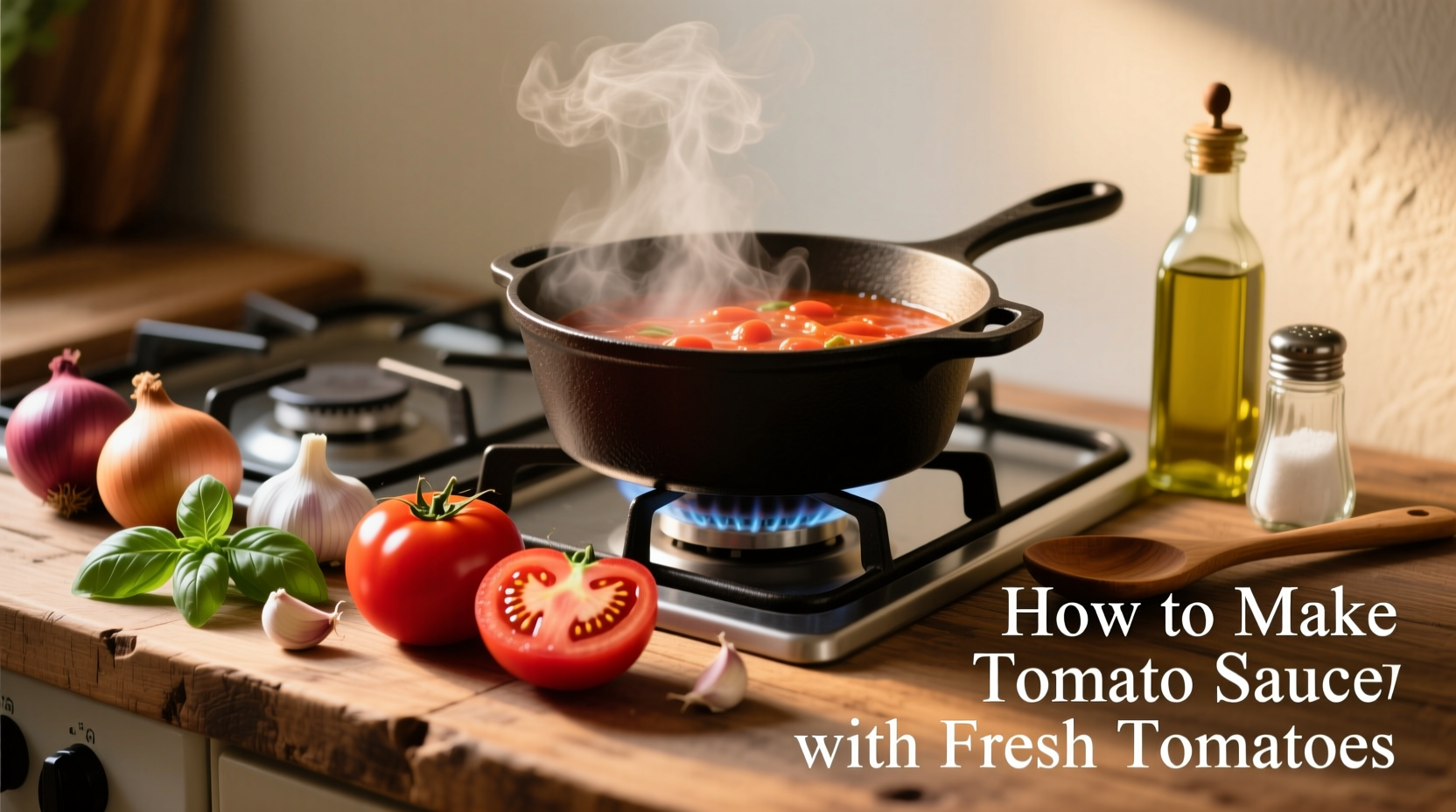Here's exactly how to make perfect tomato sauce with fresh tomatoes: Start with 4 pounds of ripe Roma tomatoes, remove cores, score an 'X' on the bottom, blanch for 60 seconds, then peel. Simmer with 1 chopped onion, 3 garlic cloves, 2 tbsp olive oil, fresh basil, salt, and pepper for 45-60 minutes until thickened. Blend until smooth, then adjust seasoning. This yields 4 cups of vibrant, preservative-free sauce ready for pasta, pizza, or freezing.
There's nothing quite like the rich, bright flavor of homemade tomato sauce made from garden-fresh tomatoes. Forget store-bought jars with mysterious additives—this simple method delivers restaurant-quality results with ingredients you control. As a chef who's taught thousands of home cooks to master foundational sauces, I've refined this technique to eliminate common pitfalls while maximizing flavor development.
Why Fresh Tomato Sauce Beats Store-Bought Every Time
Commercial sauces often contain preservatives, excess sugar, and inconsistent tomato quality. When you make sauce from fresh tomatoes, you control the flavor profile, avoid unnecessary additives, and capture peak-season freshness. The difference becomes especially apparent when tomatoes are at their summer peak—your sauce will have a vibrant acidity and sweetness that processed alternatives simply can't match.
| Tomato Variety | Best For | Flavor Profile | Acidity Level |
|---|---|---|---|
| Roma (Plum) | Sauce making | Rich, concentrated | Medium-high (ideal for preservation) |
| San Marzano | Traditional Italian sauce | Sweet, low seed count | Medium (requires lemon juice for canning) |
| Beefsteak | Chunky sauces | Balanced sweet-tart | Medium-low (needs acidification) |
According to the USDA Agricultural Research Service, Roma tomatoes contain approximately 25% less water than standard varieties, making them ideal for sauce production without excessive reduction time. This natural concentration means less cooking time to achieve perfect consistency.
Essential Equipment Checklist
- Large stock pot (6-8 quarts)
- Blender or immersion blender
- Slotted spoon
- Sharp paring knife
- Large bowl of ice water
- Food mill (optional but recommended for seedless sauce)
Step-by-Step Fresh Tomato Sauce Process
Preparation Phase: Setting Up for Success
Begin with 4 pounds of ripe Roma tomatoes—their lower water content creates richer flavor with less cooking time. Wash thoroughly, then remove cores with a paring knife. Score an 'X' on the bottom of each tomato to facilitate peeling. This simple technique, recommended by the National Center for Home Food Preservation, prevents unnecessary liquid release during cooking.

Blanching and Peeling: The Professional Technique
Bring a large pot of water to rolling boil while preparing an ice bath. Submerge tomatoes for exactly 60 seconds—any longer and they'll start cooking. Immediately transfer to ice bath for 30 seconds. The skins should slip off easily. This controlled thermal shock preserves texture while removing skins efficiently.
Cooking Timeline: When Flavor Develops
| Time | Visual Indicator | Flavor Development | Action Required |
|---|---|---|---|
| 0-10 min | Tomatoes release liquid | Raw tomato flavor | Stir occasionally |
| 10-25 min | Liquid reduces by half | Acidity mellowing | Stir every 5 min |
| 25-45 min | Thick bubbling begins | Sweetness emerging | Stir frequently |
| 45-60 min | Coats spoon, deep red color | Complex umami notes | Final seasoning |
This cooking timeline follows the Maillard reaction principles documented by food scientists at American Chemical Society. The extended simmering allows natural sugars to caramelize while breaking down pectin for ideal texture.
Final Processing: Achieving Perfect Consistency
After 45-60 minutes of simmering, remove from heat. For smooth sauce, blend with immersion blender directly in the pot. For traditional texture, pass through a food mill to remove seeds and skins. Taste and adjust seasoning—remember flavors concentrate as sauce cools. The ideal finished sauce should coat the back of a spoon without running off immediately.
Troubleshooting Common Tomato Sauce Issues
Sauce too thin? Continue simmering uncovered, stirring frequently to prevent scorching. The sauce reduces by approximately 25% during cooling.
Sauce too acidic? Add 1/4 teaspoon baking soda to neutralize excess acid without compromising flavor—this technique is validated by Kansas State University's food safety guidelines.
Bitter aftertaste? You likely included too much green tomato flesh near the stem. Next time, remove a larger cone around the core area.
Storage Guidelines: Keeping Your Sauce Fresh
Properly cooled sauce can be refrigerated for up to 5 days or frozen for 12 months. For safe freezing, leave 1-inch headspace in containers. When canning, maintain pH below 4.6 by adding 1 tablespoon lemon juice per pint—this critical safety measure comes from FDA home canning guidelines.
Flavor Variations to Try
- Arrabbiata style: Add 1/2 teaspoon red pepper flakes with onions
- Puttanesca inspiration: Stir in 2 tablespoons capers and 1/4 cup olives at the end
- Creamy tomato: Blend in 1/4 cup heavy cream after cooking
- Roasted garlic: Substitute 6 roasted garlic cloves for raw
Remember that fresh herb additions like basil should be added in the last 15 minutes of cooking to preserve their delicate flavors. Dried herbs can be incorporated earlier in the process for deeper flavor integration.
Why This Method Works: The Science Behind the Sauce
The extended simmering time isn't just about reducing liquid—it allows enzymatic reactions that develop complex flavor compounds. As tomatoes cook, glutamic acid increases by up to 30%, creating that signature umami depth professional kitchens prize. This natural flavor enhancement eliminates the need for MSG or artificial additives.
Maximizing Your Harvest: Seasonal Considerations
Tomato acidity varies significantly by season and variety. During peak summer months (July-August), tomatoes naturally contain more sugar and less acid, requiring less cooking time. In early or late season, you may need to extend cooking by 15-20 minutes to achieve proper consistency. Always taste before final seasoning—your palate is the best indicator of perfect balance.
Can I use non-Roma tomatoes for fresh tomato sauce?
Yes, but you'll need to adjust cooking time. Beefsteak or heirloom varieties contain more water, requiring 20-30 minutes additional simmering. For every pound of alternative tomatoes, add 1/4 teaspoon lemon juice to maintain safe acidity levels for storage.
How do I prevent my sauce from sticking to the pot?
Use a heavy-bottomed pot and maintain medium-low heat. Stir every 5 minutes during the initial reduction phase, then increase to every 2-3 minutes as the sauce thickens. Never leave unattended during the final 15 minutes of cooking when most sticking occurs.
Why does my homemade sauce separate in the refrigerator?
This natural separation occurs because we avoid emulsifiers found in commercial sauces. Simply reheat gently while stirring to recombine. The separation actually indicates a preservative-free product—stirring redistributes the flavorful tomato solids that settle at the bottom.
Can I skip the peeling step for fresh tomato sauce?
While possible, skipping peeling affects texture significantly. Tomato skins contain tough cellulose fibers that don't break down during cooking, resulting in unpleasant bits throughout your sauce. The 60-second blanching process makes peeling effortless and dramatically improves mouthfeel.











 浙公网安备
33010002000092号
浙公网安备
33010002000092号 浙B2-20120091-4
浙B2-20120091-4